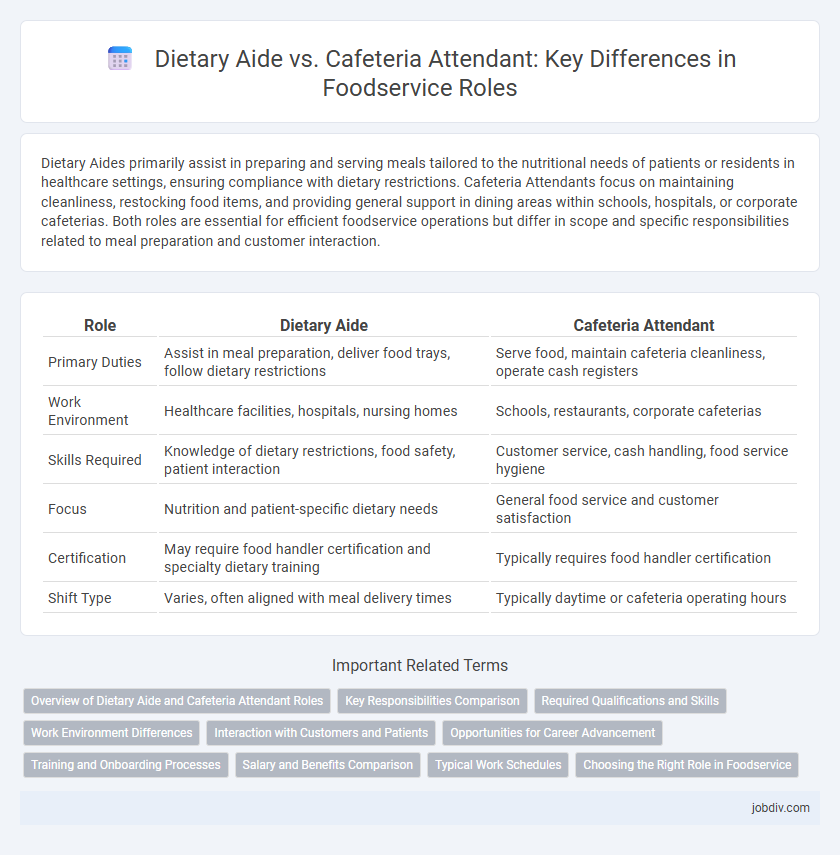Dietary Aides primarily assist in preparing and serving meals tailored to the nutritional needs of patients or residents in healthcare settings, ensuring compliance with dietary restrictions. Cafeteria Attendants focus on maintaining cleanliness, restocking food items, and providing general support in dining areas within schools, hospitals, or corporate cafeterias. Both roles are essential for efficient foodservice operations but differ in scope and specific responsibilities related to meal preparation and customer interaction.
Table of Comparison
| Role | Dietary Aide | Cafeteria Attendant |
|---|---|---|
| Primary Duties | Assist in meal preparation, deliver food trays, follow dietary restrictions | Serve food, maintain cafeteria cleanliness, operate cash registers |
| Work Environment | Healthcare facilities, hospitals, nursing homes | Schools, restaurants, corporate cafeterias |
| Skills Required | Knowledge of dietary restrictions, food safety, patient interaction | Customer service, cash handling, food service hygiene |
| Focus | Nutrition and patient-specific dietary needs | General food service and customer satisfaction |
| Certification | May require food handler certification and specialty dietary training | Typically requires food handler certification |
| Shift Type | Varies, often aligned with meal delivery times | Typically daytime or cafeteria operating hours |
Overview of Dietary Aide and Cafeteria Attendant Roles
Dietary aides support foodservice operations by preparing meals according to specific dietary guidelines, ensuring nutritional needs are met for patients or residents in healthcare or institutional settings. Cafeteria attendants primarily handle food service tasks such as serving meals, maintaining cleanliness, and assisting customers in cafeteria or dining hall environments. Both roles emphasize food safety and customer service but differ in focus on meal preparation versus food distribution.
Key Responsibilities Comparison
Dietary Aides primarily assist in meal preparation and ensure dietary restrictions are followed, often working closely with healthcare professionals to meet patients' nutritional needs. Cafeteria Attendants focus on food service operations, including setting up serving lines, replenishing food items, and maintaining clean dining areas. While both roles involve food handling, Dietary Aides emphasize compliance with diet plans and patient care, whereas Cafeteria Attendants prioritize efficient food distribution and customer service in a cafeteria setting.
Required Qualifications and Skills
Dietary Aides need basic nutritional knowledge, food safety certification, and the ability to follow specific dietary plans to support patient health in healthcare settings. Cafeteria Attendants require strong customer service skills, efficient cash handling experience, and familiarity with food preparation in fast-paced environments. Both roles demand attention to hygiene standards and physical stamina for long shifts on their feet.
Work Environment Differences
Dietary Aides typically work in healthcare facilities such as hospitals or nursing homes, where they assist with meal preparation and ensure dietary restrictions are followed in a controlled, clinical environment. Cafeteria Attendants are commonly found in schools, corporate offices, or large institutions, operating in fast-paced, high-volume settings focused on serving meals quickly and efficiently. The work environment for Dietary Aides emphasizes cleanliness and patient-specific dietary needs, while Cafeteria Attendants prioritize speed, customer interaction, and managing multiple food stations.
Interaction with Customers and Patients
Dietary Aides focus on providing personalized nutrition support and dietary guidance to patients, ensuring meals meet specific medical requirements and preferences. Cafeteria Attendants primarily serve food in a cafeteria setting, emphasizing efficiency in meal distribution and general customer service without specialized dietary counseling. Interaction with customers for Dietary Aides involves patient-specific communication about dietary needs, whereas Cafeteria Attendants engage in broader, routine interactions with diverse patrons.
Opportunities for Career Advancement
Dietary Aides often have opportunities to advance into roles such as Dietitian Assistant or Nutrition Coordinator by gaining certifications in dietary management and clinical nutrition. Cafeteria Attendants can progress to supervisory or managerial positions within foodservice operations by developing skills in food safety, inventory management, and team leadership. Both roles provide foundational experience in foodservice that enables career growth through targeted training and professional development.
Training and Onboarding Processes
Dietary aides receive specialized training in nutrition and safe food handling to support patient-specific dietary needs in healthcare settings, emphasizing adherence to medical diet orders. Cafeteria attendants undergo broader onboarding focused on general food service operations, customer service skills, and maintaining hygiene standards in high-traffic environments. Both roles require compliance with food safety regulations but differ significantly in the depth of nutritional training and clinical collaboration involved.
Salary and Benefits Comparison
Dietary aides typically earn an average hourly wage ranging from $12 to $16, reflecting specialized skills in nutritional support, while cafeteria attendants usually earn between $10 and $14 per hour, focusing on food service and customer assistance. Benefits for dietary aides often include health insurance, paid time off, and access to wellness programs, which can be more comprehensive due to the clinical nature of their role. Cafeteria attendants may receive basic benefits such as meal discounts and flexible scheduling, with fewer healthcare options compared to dietary aides.
Typical Work Schedules
Dietary aides typically work shifts aligned with meal preparation and delivery times in healthcare or institutional settings, often covering early mornings, evenings, and weekends to ensure patient meal services run smoothly. Cafeteria attendants usually follow more consistent daytime schedules tied to public meal hours, such as breakfast and lunch, with shifts primarily during standard business hours in schools or corporate cafeterias. Both roles may require flexibility for weekends or holidays depending on the facility's operational hours and staffing needs.
Choosing the Right Role in Foodservice
Dietary aides primarily focus on assisting patients with meal preparation and dietary restrictions in healthcare settings, ensuring compliance with nutritional guidelines. Cafeteria attendants handle food service in institutional or commercial cafeterias, managing food presentation and customer service. Choosing the right role depends on interest in clinical nutrition support versus customer-facing foodservice operations.
Dietary Aide vs Cafeteria Attendant Infographic

 jobdiv.com
jobdiv.com